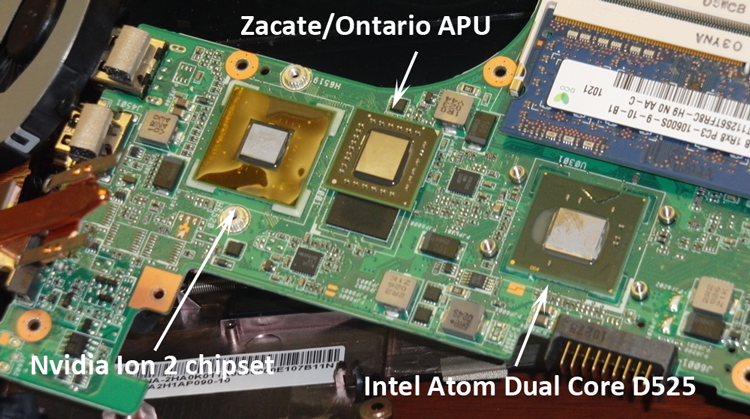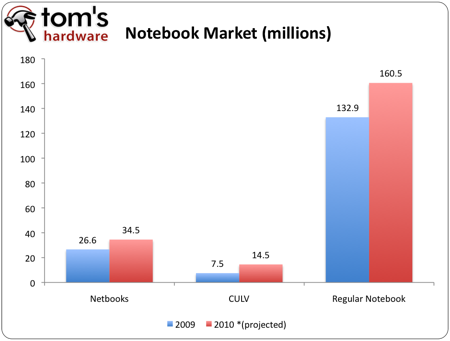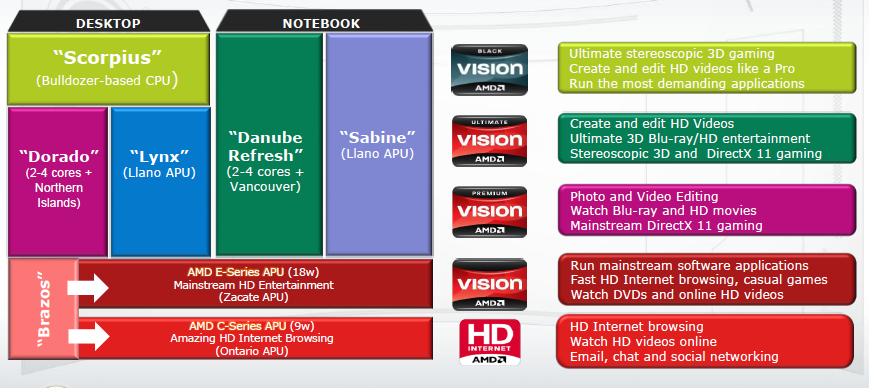AMD Fusion: Brazos Gets Previewed: Part 1
Impressions And Implications
Impressions: Performance
A few days ago, AMD invited a few people to take a peek into the performance of a Brazos notebook.
Keep in mind that we previewed the E-350, which happens to be the dual-core version of Zacate.
| Platform Specifications | Header Cell - Column 1 |
|---|---|
| CPU | AMD E-350 (Zacate)Dual-Core CPU @ 1.6 GHz128 KB L1 Cache (32 KB instruction & 32 KB data per core), 1 MB L2 Cache (512 KB per core) |
| Memory | 4 GB DDR3-1066 |
| Motherboard | AMD Engineering SampleSB750 (Hudson) Southbridge |
| Graphics | AMD Radeon HD 6310 DX11 Graphics (Wrestler) |
| Hard Drive | 128 GB Crucial SSD |
| OS/Software | Windows 7 Ultimate x64Driver 8.790 |
Performance is just about what we expected, though we won't be able to go into more depth until next week. As far as the CPU performance is concerned, the E-350 fits in similarly with what we've seen on the midrange Nile systems (K335/K125). As far as 3D performance, it approaches what AMD has already presented from a desktop Radeon HD 5400, which makes a lot of sense given that it shares architectural cues with the Cedar core. AMD is holding everyone from releasing the actual numbers for roughly another week, so stay tuned. You could already play games like World of War craft on the Nile platform. The difference is that now you can also play DiRT 2 using entry-level settings.
Impressions: Power Consumption & Heat
The numbers we got a for the E-350 platform are very impressive considering that it falls somewhere between a premium netbook configuration and a thin and light with desktop graphics.
AMD's own internal numbers show high power consumption improvements when comparing a K625 to E-350. Our numbers are similar, but remember we are interested in power consumption numbers at the platform level. At the end of the day, we really don't care about how big the battery pack is. Nor do we care about how much power x, y, or z component consumes. We measure these numbers because we care about how long we can stay away from the wall socket.
Get Tom's Hardware's best news and in-depth reviews, straight to your inbox.
Obviously, AMD prefers not to make a comparison direct comparison to Atom. But we believe that some of the dual-core Atom configurations are fair game, given the market price range--$399 to $599. We'll report back more information next week, but we have these teaser images using a very expensive T400 camera generously provided by FLIR. Keep in mind that we did not maintain the same thermal scale on these two pictures, but we will in part two of our preview.
Implications
What does all of this mean for the AMD and Intel battle? Well, what wasn't a particularly competitive marketplace before is suddenly a lot more interesting. Does Intel have something to worry about? It's too early to tell, but AMD is all but betting its future on the fact that it can usurp the chip giant.
The biggest criticism leveled against Intel time and time again is poor graphics performance. This is the reason AMD and Nvidia have the market share numbers that they do. Intel was still able to maintain a strong hold on the market because it provided OEMs a single source of hardware with a lower power profile. By the looks of Zacate, AMD is getting its house in order to cut down every advantage Intel has leisurely enjoyed.
Six months back, AMD was only missing two major system vendors from its mobile processor portfolio: Sony and Apple. As of late, AMD has achieved Sony design wins, so that really just leaves one holdout, which would be the ultimate feather in AMD's cap. Based on what we have seen with Zacate, Fusion APUs gives AMD a better-than-fighting chance to win over that last "missing vendor," given Apple's preference for low power consumption.
Zacate is an impressive work of engineering. To put it in perspective, think of fitting Nvidia's Ion 2 graphic core into Intel's dual core Atom die, while using less silicon and shrinking the package size. To do all of that and offer competitive performance is a challenge. If AMD can also add a lower price into the mix, it'll have the makings of pure win.
Thin and light notebooks, budget all-in-one desktops, and premium netbooks are all within Zacate's target range of $500. Given the volume on budget netbooks and desktop replacements, we're not sure how many Zacate chips will actually sell. It is a competitive solution, but the majority of laptop sales are elsewhere. In fact, if you remove netbooks from the equation, 15" notebooks, which we consider to be desktop replacements, account for close to 50% of all notebook sales. The other 50% can be split up between 14" and 17" notebooks. This means for AMD to really hit a home run, we need to see how far Sabine has come along.
Looking toward the future, AMD may have the "right stuff" to change the dynamics of notebook sales. Earlier in the year, an iSuppli report projected that the largest growth opportunity for notebooks was in the Consumer Ultra Low Voltage (CULV) notebook. If it turns out that Intel cannot outperform these upcoming offerings, AMD's market share victory may prove as lopsided as Intel's current grasp of the server market. At the moment, the Arrandale ULV parts rank in with a TDP of 18 W across the board. Hopefully, the mobile Llanos for the Sabine platform don't push TDP figures too far beyond Zacate's 18 W. Those mobile Arrandales, like the Core i7-660UM, carry some serious punch in the CPU department and will spank Zacate. In the short term, AMD is going to need to convince system builders that good graphics performance is better than having an overabundance of processor horsepower.
Inevitably, AMD still needs to find ways to engage the brick and mortar (B&M) customer that walks in to a Best Buy. That was the reason behind the conception of the Vision campaign, and it is something it need to keep its eyes on (I still can't see Vision being as successful as Centrino was).
For those of us who can compare clock speeds, cache sizes, and core architectures, the buying decision is a more evaluative process. However, AMD's success depends as much on customers who nit pick about performance (and influence the purchases of friends and family) as those who don't. AMD in some ways still carries this stigma of too much power, too much heat. It's also still finding that it needs to shake off the reputation of being Intel-alternative versus simply standing on its own merits. AMD Fusion has all the indicators of being able to breathe new life into the company's performance portfolio. What is left is how the company handles its newfound weapon.
Current page: Impressions And Implications
Prev Page Ontario/Zacate (Bobcat-Based APUs) And Beta Drivers-
bombat1994 awesome to see amd get into the netbook centre, finally show the public how badly the atom is clock for clockReply -
Interesting to see them projecting an increased market in netbooks given all the high profile remarks about Tablets supposedly cannibalizing it.Reply
-
acku Tablets get us into a whole other portion of the debate, as we need to start also talk about demographics. The short version of the conversation - keep in mind that a cannibalized market doesn't necessarily mean a decrease in the volume. It generally translates into a slow down in growth and a smaller proportional market.Reply
Cheers,
Andrew Ku
TomsHardware.com -
joytech22 AMD has and always will kick Intel's ass in the IGP market (excuse the rude but necessary language)Reply
Well, at least that's what i think, probably going to get downed a bit. -
compton The more the merrier. My hope is that AMD can leverage this launch into a successful campaign, then bring more competitive desktop solutions to people like me, looking at my Phenom II, then looking at the Intel 32nm core i3 that can meet or beat it... and gets worse from there. If Brazos doesn't do so hot, AMD's gonna need some serious tricks (like a miracle) to bring the heat to Intel. My Phenom II is pretty good stacked against the Core 2 but its almost 2011. Bring the funk AMD! Or let me know if you decide to... well, not. I'm ready for it now.Reply -
dEAne While AMD cannot go straight with intel in big CPU battles he makes little ones like david to bite it's toes to make intel preoccupied until bulldozer arrives.Reply -
super_tycoon Trust me, I've tried playing dirt2 on a ultra-thin and you get miso soup for graphics. A kind of foggy, blurry slurry; it's not something you really want to be associated with.Reply -
SteelCity1981 If the Graphics Core is based on the Evergreen architecture then why not just call it Radeon 5250 and 5310 series? It's just confusing to the consumor standpoint to call a Radeon GPU a 6250 and a 6310 when it's based on the Radeon 5 series. Especially considering there will be no new Radeon 6 series that will come out lower then the 6800 series.Reply -
lunyone Let's see my wishlist in a netbook or equivalent:Reply
* Decent battery life (if needed for plane trips) *possibly??
* Around 15" screen (I like this size, 10" seems too small for me) *possibly??
* Be able to play HD (whether online or off a DVD) *sounds like a good possibly??
* Be able to play most recent games on (even low settings is fine) *possibly??
*







